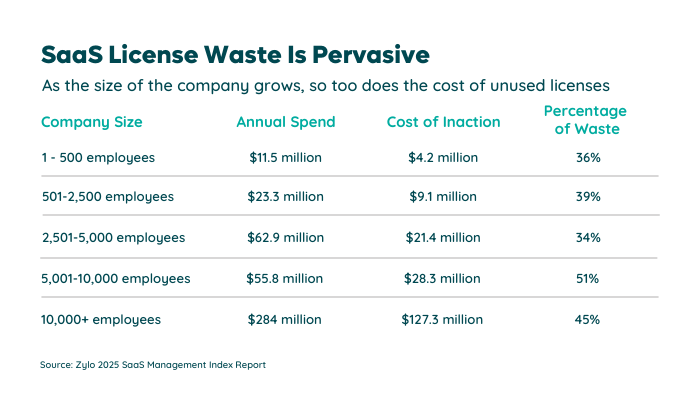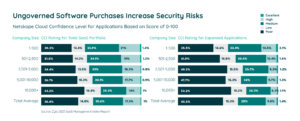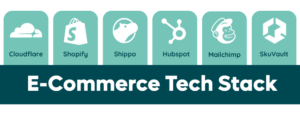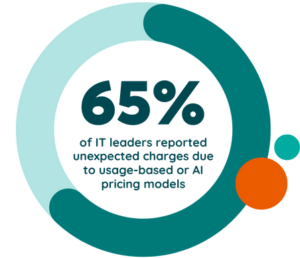Table of Contents
Modern e-commerce businesses run on tech. But as stacks grow more complex, many leaders find themselves buried under disconnected tools, ballooning costs, and unclear ROI. Instead of accelerating growth, a poorly managed stack becomes a drag on performance and budget.
Simplifying your e-commerce tech stack is a forward-thinking decision that positions your business for long-term success. With the rise of AI-native tools, consumption-based pricing, and hundreds of overlapping platforms, companies must rethink how they build, evaluate, and manage their technology investments. The goal is to use the right tech, at the right time, with full visibility into how it drives outcomes.
This guide will break down what goes into an e-commerce tech stack, the challenges of managing it at scale, and how to build a more agile, cost-effective foundation for long-term success.
What Is an E-Commerce Tech Stack?
An e-commerce tech stack is the collection of technologies and tools that power your online store, from the platform customers see to the systems running in the background. These stacks typically include everything from your e-commerce platform (such as Shopify or Magento) to customer support tools, analytics, fulfillment software, and payment gateways.
Today’s modern tech stacks are increasingly modular and integrated. Businesses often combine best-in-class solutions to handle marketing, inventory, CRM, and personalization. This composability (the ability to assemble and reassemble components in a flexible, plug-and-play manner) gives retailers the flexibility to swap out tools as needs change, but it also introduces complexity. Without a strong foundation of visibility into your full stack, that complexity can lead to inefficiencies, wasted spend, and missed revenue opportunities.
Why Your E-commerce Tech Stack Matters More Than Ever
Your tech stack goes well beyond being a simple list of tools. It serves as the infrastructure behind every customer interaction, internal workflow, and revenue-generating operation. When it’s well-managed, it powers scalable growth. When it’s not, it drains resources and adds risk.
Let’s explore what a strong, simplified e-commerce stack delivers.
Lower Costs Through Smarter Software Investment
With SaaS spending now averaging $49M per organization annually, a 9.3% year-over-year increase, stack sprawl is no longer sustainable. A streamlined tech stack helps businesses eliminate unnecessary licenses, reduce shelfware, and renegotiate smarter renewals, especially as AI features introduce new pricing complexities.

Effective SaaS Management can reduce waste by identifying unused licenses, consolidating redundant applications, and surfacing more favorable contract terms. Zylo data shows that 55% of licenses in the average enterprise go unused, making cost optimization an immediate win.

Centralized Oversight for Better Governance
As e-commerce operations scale, managing hundreds of apps across departments becomes chaotic. Centralized governance simplifies oversight by consolidating tools into a centralized system of record, giving IT, procurement, and finance shared visibility.
Using a cross-functional approach improves governance, ensures policy compliance, and prevents the hidden cost of shadow IT. Establishing foundational practices in inventory, license, and renewal management helps keep tech operations aligned and efficient.
More Productive Teams, Less Workflow Friction
Disconnected tools slow teams down. With the average company using 275 SaaS applications, employees often switch between dozens of interfaces to complete simple tasks. A cohesive stack streamlines workflows, reduces cognitive load, and gives teams faster access to the tools they need.
More importantly, smart stack design ensures you’re paying for tools that actually enhance productivity, not just clutter the digital workspace.
Stronger Security and Risk Mitigation
Poorly managed stacks create blind spots, which in turn introduce risk. In fact, 60.8% of expensed apps in the average organization carry a “Poor” or “Low” risk score. These unmonitored tools can expose e-commerce businesses to serious security and compliance issues.
Centralized SaaS Management enables organizations to identify high-risk apps, enforce compliance policies, and reduce exposure. From GDPR to PCI DSS, a controlled stack helps businesses stay audit-ready.

Unified Data and Better Decision-Making
Modern e-commerce stacks generate data across every touchpoint. But without integration, that data lives in silos. A well-orchestrated tech stack ensures data flows between systems, so you can make decisions based on unified, accurate insights.
This is especially important as businesses adopt AI, because these tools are only as good as the data they’re built on. Clean, centralized data management ensures that your stack supports your AI investments instead of undermining them.
Agility to Adapt as Your Business Grows
Perhaps the most underrated benefit of a simplified stack is flexibility. When your tools are modular, interoperable, and governed by a clear framework, your business can scale faster, experiment more, and adapt to change without breaking workflows or budgets.
As AI accelerates software creation and usage-based pricing reshapes contracts, e-commerce leaders need tech stacks that evolve with them, not against them.
What to Look for When Choosing Your E-commerce Tech Stack
The right tech stack fuels growth. The wrong one creates bottlenecks and bloat. With more tools than ever promising innovation, it’s easy to overbuy or invest in platforms that don’t scale with your business. Before signing a contract or launching another app, ensure you’ve thoroughly evaluated these core considerations.
Prioritize ROI and Long-Term Affordability
Budgets need to consider both sticker price and the cost of ownership when it comes to choosing a tech stack, including licensing, implementation, training, and maintenance.
With the rise of AI pricing models and consumption-based fees, cost predictability has become a top concern for IT leaders.
Instead of defaulting to premium-tier subscriptions, evaluate which tools actually deliver value per user. Are you paying per seat but only using half? Are add-ons inflating your costs year over year? Budget decisions should reflect both current needs and growth projections.
Evaluate Complexity and Admin Burden
Tools that require constant oversight drain internal resources. As stacks grow, ease of use matters for admins, power users, and occasional contributors alike. SaaS solutions should be intuitive to onboard, manage, and report on without excessive training or third-party support.
Look for platforms that offer low-code or no-code customization, clean dashboards, and automation features that reduce manual upkeep.
Demand Seamless Integration with Your Existing Tools
Every new app should work with the rest of your ecosystem. Disconnected tools create data silos, slow down processes, and increase the risk of human error. Integration should be a key consideration when choosing the tools in your tech stack.
Check for native integrations, open APIs, and middleware compatibility. Does the vendor support common platforms like your CRM, ERP, or analytics stack? A composable architecture makes it easier to future-proof your business.
Don’t Overlook the Importance of Support
Your tech stack is only as reliable as the support behind it. When issues arise, will your team wait days for answers or get real-time help? Strong vendor support is especially crucial for e-commerce businesses, where downtime can have a direct impact on revenue.
Look for providers with accessible documentation, responsive chat or phone support, and customer success teams that understand your business model.
Choose Tools That Enhance the End-User Experience
Whether it’s your internal teams or your customers, usability matters. Laggy interfaces, confusing navigation, or inconsistent performance chip away at productivity and satisfaction. A great user experience translates into faster adoption and fewer support tickets.
Ask for demos, trial access, or customer case studies. The smoother the experience, the more likely your team will embrace it, and your customers will notice.
Plan for Scalability and Change
Business needs evolve. Your tech stack should, too. Select tools that can scale with your growth, adapt to new workflows, and integrate emerging technologies such as AI or real-time personalization.
Look for flexible licensing models, role-based access, and analytics that give you insights as usage changes over time. A platform that fits today but breaks tomorrow is a risk not worth taking.
Core Components That Power an Effective E-commerce Tech Stack
A high-performing e-commerce tech stack is more than the sum of its parts. It’s a connected ecosystem that supports every stage of the customer journey, while staying manageable for internal teams. Below are the key components that form the foundation of a modern, scalable stack, along with examples and how they work together to maximize ROI.
Reliable Website Hosting for Speed and Stability
Your hosting provider underpins every interaction on your site. It affects page load times, uptime, and scalability during traffic spikes. For example, Cloudflare or AWS can deliver global content distribution and auto-scaling during high-traffic events. When integrated with your CMS and security tools, hosting becomes an invisible engine that keeps everything running smoothly.
Flexible CMS and Website Builders
A content management system (CMS) enables you to build and update your site without requiring coding for every change. Tools like Contentful or Shopify’s CMS allow teams to launch new landing pages, update product descriptions, and personalize content in minutes. When your CMS connects to your CRM and marketing tools, you can dynamically display product recommendations or targeted promotions based on user history.
CRM Systems That Centralize Customer Data
Customer relationship management platforms like Salesforce or HubSpot track customer profiles, purchase history, and engagement. This data feeds into email campaigns, loyalty programs, and support workflows. A unified CRM integration ensures your marketing, sales, and service teams are all working from the same source of truth, reducing friction and improving conversion rates.
Marketing Tools That Drive Demand
Platforms like Klaviyo or Attentive manage email, SMS, and retargeting campaigns. Integrated with your CRM and CMS, they can automate personalized messages based on browsing behavior or cart status. For example, Klaviyo can trigger an abandoned cart email tied to real-time product availability, ensuring every message is timely and relevant.
Analytics and Reporting Tools for Real-Time Insight
Tools like Google Analytics 4 or Mixpanel give you deep insight into how users interact with your site and where conversions drop off. When integrated with your e-commerce platform and CRM, you can tie campaign performance directly to revenue outcomes and adjust spend accordingly. A unified dashboard simplifies performance tracking across the full stack.
Inventory Management Tools to Reduce Friction
Solutions like SkuVault or NetSuite sync product availability across warehouses, channels, and your storefront. This integration ensures accurate product listings and prevents overselling. Combined with analytics and shipping tools, inventory data helps you forecast demand and reduce fulfillment delays, improving both margin and customer satisfaction.
Tools to Streamline Shipping and Returns
Platforms like Shippo or Loop Returns manage logistics, track packages, and automate the returns process. When connected to your CRM and inventory system, these tools can proactively alert customers to delays and automatically update stock levels. This integration streamlines the post-purchase process and reduces the number of support tickets.
Security Tools That Protect Your Stack and Customers
Security solutions like Auth0 for identity management or Akamai for web application firewalls ensure safe, compliant transactions. When integrated across your stack, they help enforce access controls and prevent data leaks. Security isn’t just protection; it’s a revenue-preserving layer that earns customer trust.
Customer Service Tools That Close the Loop
Helpdesk platforms like Zendesk manage support tickets, live chat, and self-service options. When integrated with your CRM, order system, and marketing stack, agents can access a customer’s full history instantly, reducing resolution time and improving customer satisfaction. Seamless service supports retention, which boosts ROI long after the initial sale.

How Today’s Top E-commerce Platforms Stack Up
Choosing the right e-commerce platform is foundational to building a tech stack that scales. Each platform has its strengths and trade-offs, depending on your business size, technical resources, and long-term goals. Below are four of the most widely used platforms.
Shopify
Shopify is a hosted, all-in-one e-commerce platform built for speed, ease of use, and fast time to market. It’s a favorite among direct-to-consumer (DTC) brands and small to mid-sized businesses that want a reliable platform without the heavy technical lift. Shopify Plus offers enterprise-grade features to help you scale your brand.
Pros:
- Quick to launch and easy to use
- App marketplace for plug-and-play functionality
- Excellent uptime and performance
- Strong ecosystem of templates, partners, and integrations
Cons:
- Less flexibility for custom development
- Transaction fees, unless using Shopify Payments
- Limited native multi-language and multi-currency support without add-ons
Magento (Adobe Commerce)
Magento is an open-source platform known for flexibility and scalability. Now owned by Adobe, Magento Commerce (the paid version) targets enterprise businesses with complex requirements and in-house development teams.
Pros:
- Highly customizable for complex workflows and catalogs
- Strong B2B and multi-storefront capabilities
- Deep integration with Adobe Experience Cloud
Cons:
- High development and hosting costs
- Requires technical expertise to manage and update
- Longer time to launch compared to hosted platforms
WooCommerce
WooCommerce is a plugin that transforms a WordPress site into a fully functional e-commerce store. It’s highly customizable and ideal for content-heavy sites or brands already on WordPress. You host it yourself, giving you complete control over the stack.
Pros:
- Low barrier to entry and no licensing fees
- Deep integration with WordPress CMS
- Flexible with themes and plugins
Cons:
- Requires more hands-on maintenance and security oversight
- Performance depends heavily on your hosting setup
- Scaling may require significant developer resources
BigCommerce
BigCommerce is a SaaS e-commerce platform designed for growing and mid-market brands. It offers robust built-in features and open APIs, making it a good hybrid between hosted ease and customization potential.
Pros:
- No transaction fees, even with third-party gateways
- Strong built-in SEO and omnichannel tools
- Headless commerce options via BigCommerce API
Cons:
- Learning curve steeper than Shopify for new users
- Limited themes compared to competitors
- Some advanced features are reserved for higher-tier plans
Ultimately, the best e-commerce platform is the one that aligns with your business model, team resources, and growth strategy. Whether you prioritize ease of use, deep customization, or robust B2B features, each of these platforms can serve as the foundation of a scalable tech stack if integrated and managed thoughtfully.
Take the time to evaluate not just what you need today, but what your stack will need to support six months, a year, or three years from now.
What’s Next: The Future of E-commerce Tech Stacks and AI Integration
E-commerce tech stacks are evolving fast, and AI is accelerating that evolution. What used to be a static set of tools is now a dynamic, interconnected system where automation, personalization, and intelligent decision-making play a growing role. Businesses that embrace this shift will be better equipped to adapt, scale, and compete.
How AI Is Accelerating E-commerce Evolution
 AI-native tools are already reshaping key areas of e-commerce, from predictive merchandising and dynamic pricing to chat-based customer service and hyper-targeted marketing. AI-driven features are a leading cause of both rising costs and growing opportunity, with 66.5% of IT leaders reporting unexpected charges tied to AI or consumption-based pricing models. That makes visibility, governance, and adaptability even more important.
AI-native tools are already reshaping key areas of e-commerce, from predictive merchandising and dynamic pricing to chat-based customer service and hyper-targeted marketing. AI-driven features are a leading cause of both rising costs and growing opportunity, with 66.5% of IT leaders reporting unexpected charges tied to AI or consumption-based pricing models. That makes visibility, governance, and adaptability even more important.
What It Takes to Build an AI-Ready Stack
E-commerce leaders will need to strike a balance between innovation and control. The future stack will be less about adding more tools and more about orchestrating them effectively. AI agents will increasingly act as collaborators, making decisions, optimizing workflows, and even building lightweight tools on the fly. But to deliver results, these agents must be built on clean data, connected platforms, and well-managed environments.
A tech stack built for future needs must be both AI-compatible and AI-ready. That means composability, security, and real-time data access are foundational.
Build a Smarter, More Scalable E-commerce Stack with Zylo
Your e-commerce tech stack should be an engine for growth instead of a source of hidden costs and complexity. However, as tools multiply and pricing models evolve, visibility and control become increasingly challenging to maintain. That’s where Zylo comes in.
Zylo provides a comprehensive view of your SaaS environment, enabling you to manage licenses, optimize renewals, and identify waste before it impacts your bottom line. Whether you’re scaling your e-commerce operation or adapting to AI-native tools, Zylo helps IT leaders optimize their tech stacks to reduce waste, enhance performance, and increase business value.
Ready to learn more? Request a demo today!
E-commerce Tech Stack FAQ
What technology is used in e-commerce?
E-commerce uses front and back-end tools like CMS platforms, databases, payment processors, and cloud services. These technologies deliver fast, secure, and personalized shopping experiences.
What is the best tech stack to build an e-commerce website?
The best stack depends on your size and goals. Shopify or WooCommerce work well for small teams, while Magento or headless stacks suit larger, more complex operations.
Why is having the right tech stack critical for e-commerce?
Your tech stack affects everything from site speed to customer service. A well-integrated stack reduces waste, boosts performance, and supports your company’s long-term growth.
What is the most common technology stack for an e-commerce marketplace?
Many use the LAMP stack (or are moving over to JAMstack) and headless architectures with tools like React, GraphQL, and Stripe. These offer flexibility, modularity, and scalability.
How do I choose the right e-commerce tech stack for my business?
Consider your budget, tech skills, launch speed, and growth needs. Choose tools that integrate well and support future scaling. A SaaS Management platform can also help you assess usage, costs, and gaps in your current stack, giving you data to make more informed decisions before adding or switching tools.

